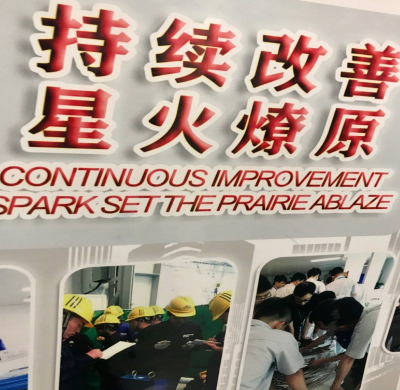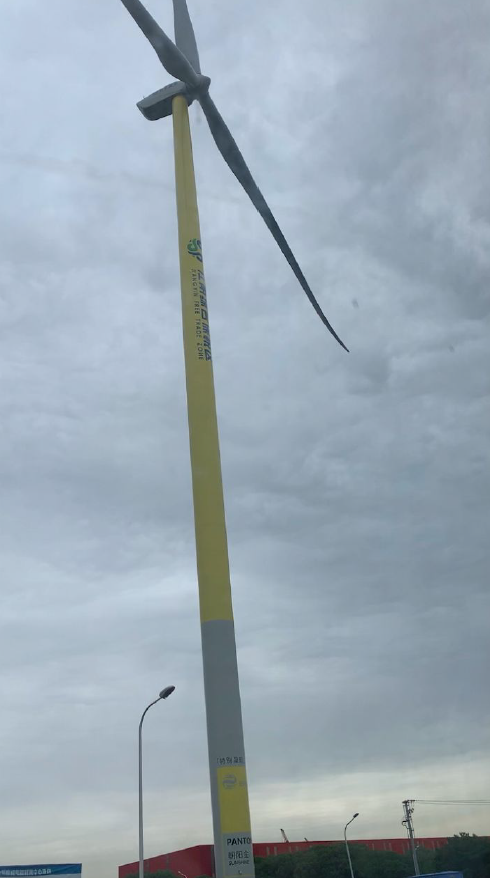Envision Energy: Building a Global Smart Energy Ecosystem
June 9, 2019
On May 30, 2019, we traveled to the city of Jiangyin in the Jiangsu Province to visit Envision Energy. Envision Energy was founded in 2007 by Lei Zhang on the basis that everyone deserves access to “clean, secure, and affordable energy.” Envision places a strong emphasis on the belief that renewable energy and smart technology within the IoT (Internet of Things) will redefine the future and energy crisis the world is facing. Their current central product focus is wind technology and digital energy technology. Though headquartered outside of Shanghai in China, they have offices and R&D centers across Europe, Asia, and North and South America.
Upon our arrival to Envision Energy we were shown into the “control room” of the office for a presentation by Grace Lu, the head of the facility. We learned about Envision’s current statistics and plans to move forward with their company. They have three manufacturing facilities in China, and 174 wind farms in China alone. The company is the number two producer of wind turbines in China and the fifth largest producer in the world. Producing both onshore and offshore wind turbines, Envision is leading the development of low speed onshore turbines which function when wind speeds aren’t strong. Not only does Envision manufacture and provide the turbines to customers, they also focus on management systems of their turbines to improve efficiency and stability of the energy source. Envision provides top-notch data monitoring systems to ensure smooth and safe energy production.
The factory we visited after the presentation is the biggest turbine factory in all of China, producing onshore wind turbines. Taking up to 13 steps to build, the company can manufacture 2,000 turbines a year, each producing 2 megawatts of energy. The biggest takeaway from our discussion with Grace and the following tour of the factory and training space was the global perspective the company possesses. They are focused on several different areas across the world and a diverse set of global markets.
One aspect of the company we found to be unique and beneficial to the global focus of Envision was the management system. Beyond the regular hierarchy, Envision created a Global Advisory Board to assist them with their operations. This board meets three times a year to discuss financial status, risk management, and global positioning. The Global Advisory Board contains some renowned members, including Dr. Arun Majumdar who was Ex-VP for Google Energy and worked under the US Department of Energy, and Shaun Kingsbury who is the Ex-CEO for the UK Green Investment Bank. Grace emphasized the company felt strongly that to have a global perspective they needed a global team. The board has helped Envision expand its business based on the demand of global markets and set up R&D and manufacturing centers in viable areas. Another way Envision Energy goes above and beyond other companies we visited is its focus on employee interaction. Factory employees go through extensive training, testing, and even a special skills competition to encourage constant improvement and excellence within the company. Along with skill development, Envision sits down with each employee and comes up with a personal development plan for their future within the department. Our guide during this part of the factory tour stated that they do this not only for the employees, but because it helps Envision increase its quality and efficiency. These unique forms of global and employee management are a major part of what is helping Envision grow at such a steady rate in the energy market.

Envision prides itself in creating and implementing smart technology that facilitates energy management and distribution. As we learned on our visit, the company has managed to balance design and the economics of manufacturing with affordability. Envision has three integrated management systems: Apollo PV, Smart Storage and EnOS through which they are carrying out their focus on implementing a “comprehensive global energy IoT and smart city ecosystem”. EnOS is their main cloud-based renewable energy software enabling transparency, predictive maintenance and better grid integration. The operating system has already connected over 50 million smart devices used for wind, solar and energy storage. Using EnOS, Envision is able to centralize clean energy, improving efficiency of the grid, and monitors the largest IoT platform in the world, essentially acting as a virtual power plant. During the company visit, we were able to see over 80 million pieces of real-time data on screen and we were told that the data EnOS collects has over 90% accuracy. Collected data is used to ensure the production of the forecasted energy, full life-time management, choosing the best turbines, making the best solutions and design optimization. This advanced smart technology has enabled the company to uphold its commitment to facilitating the affordability of clean energy.

Envision Energy’s main slogan is “Bring the Beautiful Energy Closer to You”. With this in mind, the “beautiful” clean energy they manufacture through wind turbines not only considers efficiency but also aesthetics. Through its own advanced AI technology, specifically the EnOS software, Envision is the first wind turbine manufacturer to develop “smart turbines” that use smart control, an expert data analysis system and active performance control to accurately determine their own status to ensure optimal operation. This has enabled their wind turbine power efficiency to increase by 15%. Envision has collaborated with the famous Italian designer Stefano Giovannoni to add a sense of art to the design of their turbines that still enhances efficiency. During the company visit we learned that rotor size is much larger than it was 10 years ago, and that bigger turbines require much more mature supply chains. While discussing the economics of manufacturing wind turbines, the question about their competitiveness or compatibility with the solar energy industry was brought up. The answer to how expensive it is to build a wind turbine was not explicitly stated, however, we were told that the wind industry is very competitive in the renewables market as wind farms take up much less land space than solar farms. It was also noted that in China there is a serious problem with pollution and fine dust, which cover solar panels reducing their output and requiring more maintenance, making wind energy much more competitive.
Looking to the future, Envision is committed to building a smart energy ecosystem. They have invested in a variety of companies that pioneer in IoT, big data, smart grid, storage, security and more. Since the battery is the future of energy storage, Envision has recently purchased Nissan’s battery manufacturing business, expanding its presence in the energy storage field. In China, local companies have been growing a lot more than international brands because of their knowledge of the Chinese market enabling better capability and service. For Envision, China and India are the most promising markets for wind energy because of their recent commitments to renewable energy in response to their major roles as carbon dioxide emitters. The company also continues to emphasize R&D in its efforts to incorporate storage into its wind farms. The commitment to globalization and focus on smart development sets up Envision Energy to continue to be a driving force in the future of renewable energy and storage.
About the Author
Karina Goco, Sarah Padyk
